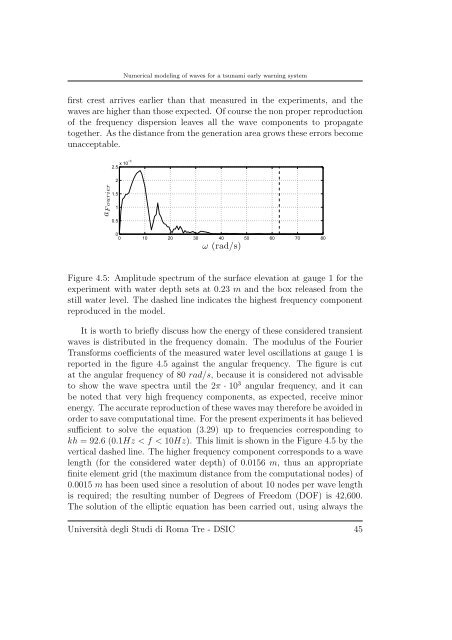Numerical modeling of waves for a tsunami early warning system
Numerical modeling of waves for a tsunami early warning system
Numerical modeling of waves for a tsunami early warning system
You also want an ePaper? Increase the reach of your titles
YUMPU automatically turns print PDFs into web optimized ePapers that Google loves.
<strong>Numerical</strong> <strong>modeling</strong> <strong>of</strong> <strong>waves</strong> <strong>for</strong> a <strong>tsunami</strong> <strong>early</strong> <strong>warning</strong> <strong>system</strong><br />
first crest arrives earlier than that measured in the experiments, and the<br />
<strong>waves</strong> are higher than those expected. Of course the non proper reproduction<br />
<strong>of</strong> the frequency dispersion leaves all the wave components to propagate<br />
together. As the distance from the generation area grows these errors become<br />
unacceptable.<br />
aFourier<br />
x 10−3<br />
2.5<br />
2<br />
1.5<br />
1<br />
0.5<br />
0<br />
0 10 20 30 40 50 60 70 80<br />
ω (rad/s)<br />
Figure 4.5: Amplitude spectrum <strong>of</strong> the surface elevation at gauge 1 <strong>for</strong> the<br />
experiment with water depth sets at 0.23 m and the box released from the<br />
still water level. The dashed line indicates the highest frequency component<br />
reproduced in the model.<br />
It is worth to briefly discuss how the energy <strong>of</strong> these considered transient<br />
<strong>waves</strong> is distributed in the frequency domain. The modulus <strong>of</strong> the Fourier<br />
Trans<strong>for</strong>ms coefficients <strong>of</strong> the measured water level oscillations at gauge 1 is<br />
reported in the figure 4.5 against the angular frequency. The figure is cut<br />
at the angular frequency <strong>of</strong> 80 rad/s, because it is considered not advisable<br />
to show the wave spectra until the 2π · 10 3 angular frequency, and it can<br />
be noted that very high frequency components, as expected, receive minor<br />
energy. The accurate reproduction <strong>of</strong> these <strong>waves</strong> may there<strong>for</strong>e be avoided in<br />
order to save computational time. For the present experiments it has believed<br />
sufficient to solve the equation (3.29) up to frequencies corresponding to<br />
kh =92.6 (0.1Hz < f < 10Hz). This limit is shown in the Figure 4.5 by the<br />
vertical dashed line. The higher frequency component corresponds to a wave<br />
length (<strong>for</strong> the considered water depth) <strong>of</strong> 0.0156 m, thus an appropriate<br />
finite element grid (the maximum distance from the computational nodes) <strong>of</strong><br />
0.0015 m has been used since a resolution <strong>of</strong> about 10 nodes per wave length<br />
is required; the resulting number <strong>of</strong> Degrees <strong>of</strong> Freedom (DOF) is 42,600.<br />
The solution <strong>of</strong> the elliptic equation has been carried out, using always the<br />
Università degli Studi di Roma Tre - DSIC 45

















